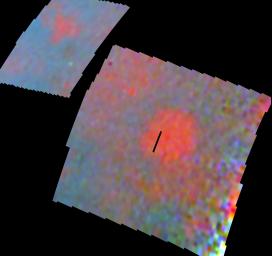
|
Callisto’s Southern Hemisphere
- Click the image above for a larger view
- Full-Res JPEG (900 x 850) (96.8 kB)
- Full-Res TIFF (900 x 850) (807.7 kB)
Caption:
These views of Callisto's southern hemisphere were taken by the Near Infrared Mapping Spectrometer just after closest approach in orbit G8 on May 6, 1997. These false color images show surface compositional differences, red = more ice, blue = less ice.
The upper left view contains Buri, a crater with a diameter of about 60 km. In the infrared spectrum, Buri and the rays that extend from the crater have high abundance of water ice compared to the surrounding region. The center view, a large (200 km or 120 mile diameter) unnamed impact crater with a distinct ring or circle around it reveals a complex mix of ice and non-ice materials. This is possibly due to impact excavation of the ice-rich subsurface which suggests that the darker material is just a thin surface covering caused by impact debris or a lag deposit from which the ice has evaporated away. The infrared data shows spectral signatures for both sulfur and carbon as two potential materials which could play a part in the complicated make-up of Callisto's surface.
Background Info:
The Jet Propulsion Laboratory, Pasadena, CA manages the Galileo mission for NASA's Office of Space Science, Washington, DC. JPL is an operating division of California Institute of Technology (Caltech).
This image and other images and data received from Galileo are posted on the World Wide Web, on the Galileo mission home page at URL http://galileo.jpl.nasa.gov.
Cataloging Keywords:
| Name | Value | Additional Values |
|---|---|---|
| Target | Callisto | |
| System | Jupiter | |
| Target Type | Satellite | |
| Mission | Galileo | |
| Instrument Host | Galileo Orbiter | |
| Host Type | Orbiter | |
| Instrument | Near-Infrared Mapping Spectrometer (NIMS) | |
| Detector | ||
| Extra Keywords | Color, Crater, Impact, Infrared, Water | |
| Acquisition Date | ||
| Release Date | 1997-11-17 | |
| Date in Caption | 1997-05-06 | |
| Image Credit | NASA/JPL | |
| Source | photojournal.jpl.nasa.gov/catalog/PIA01078 | |
| Identifier | PIA01078 | |
